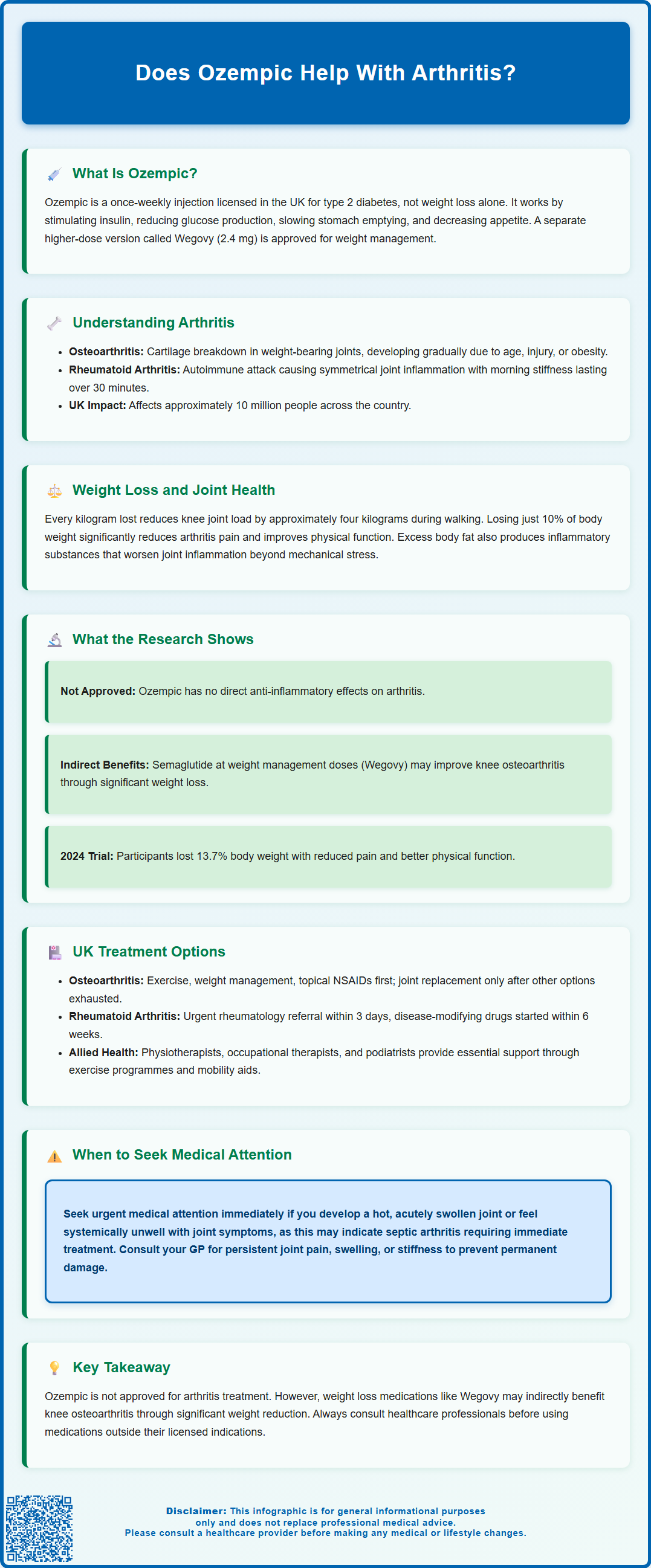Wegovy®
Similar to Ozempic, Wegovy also contains semaglutide but is licensed for weight management. It helps reduce hunger and supports meaningful, long-term fat loss.
- Supports clinically proven weight reduction
- Weekly injection, easy to use

Ozempic (semaglutide) is a GLP-1 receptor agonist licensed in the UK for type 2 diabetes management, not arthritis treatment. However, emerging research suggests that weight loss achieved with semaglutide may indirectly benefit people with osteoarthritis by reducing mechanical stress on joints and lowering systemic inflammation. Whilst Ozempic does not directly treat arthritis, understanding the relationship between weight management and joint health is important for patients exploring treatment options. This article examines the evidence, clarifies Ozempic's role, and outlines established arthritis treatments available through the NHS.
Summary: Ozempic is not licensed or indicated for arthritis treatment, but weight loss achieved with semaglutide may indirectly improve osteoarthritis symptoms by reducing joint stress and inflammation.
Ozempic (semaglutide) is a prescription medication licensed in the UK for the treatment of type 2 diabetes mellitus. It belongs to a class of drugs called glucagon-like peptide-1 (GLP-1) receptor agonists, which work by mimicking the action of a naturally occurring hormone in the body.
The mechanism of action involves several key processes:
Stimulating insulin secretion from the pancreas in response to elevated blood glucose levels
Suppressing glucagon release, which reduces glucose production by the liver
Slowing gastric emptying, which helps control post-meal blood sugar spikes
Reducing appetite through effects on brain centres that regulate hunger
Ozempic is administered as a once-weekly subcutaneous injection using a pre-filled pen device. The medication is typically started at a low dose (0.25 mg weekly) and gradually increased to therapeutic doses of 0.5 mg, 1 mg, or 2 mg weekly, depending on individual response and tolerability.
Whilst Ozempic's primary indication is glycaemic control in type 2 diabetes, it has gained considerable attention for its weight loss effects. Clinical trials have demonstrated that patients using Ozempic at diabetes doses typically experience modest weight loss of around 4-6 kg over 30-56 weeks of treatment. This occurs as a secondary benefit of the medication's effects on appetite regulation and food intake.
It is important to note that Ozempic is not licensed in the UK for weight management alone. A higher-dose formulation of semaglutide (2.4 mg weekly), marketed as Wegovy, has received MHRA approval specifically for weight management in adults with obesity or overweight with weight-related comorbidities. Wegovy treatment is associated with more substantial weight loss (approximately 15% over 68 weeks) and is available under specific NICE-recommended eligibility criteria and specialist weight management services. Ozempic should only be used under medical supervision and as prescribed by a healthcare professional.
If you experience any side effects while taking Ozempic, report them to your doctor and consider reporting them through the MHRA Yellow Card scheme (yellowcard.mhra.gov.uk).
Arthritis is an umbrella term encompassing over 100 different conditions that cause inflammation, pain, and stiffness in the joints. In the UK, arthritis affects approximately 10 million people, making it one of the most prevalent chronic health conditions according to Versus Arthritis. The two most common forms are osteoarthritis (OA) and rheumatoid arthritis (RA), each with distinct underlying mechanisms.
Osteoarthritis is a degenerative joint disease characterised by the breakdown of cartilage—the protective tissue that cushions the ends of bones. This condition typically develops gradually over time and is more common in weight-bearing joints such as the knees, hips, and spine. Risk factors include advancing age, previous joint injury, obesity, and genetic predisposition. OA causes pain, reduced mobility, and can significantly impact quality of life.
Rheumatoid arthritis, by contrast, is an autoimmune condition where the body's immune system mistakenly attacks the synovial membrane lining the joints. This results in chronic inflammation, joint damage, and systemic symptoms including fatigue and morning stiffness lasting more than 30 minutes. RA can affect multiple joints symmetrically and may also impact other organs.
According to NICE guidance, arthritis management in the UK follows a stepwise approach:
Non-pharmacological interventions: Exercise programmes, physiotherapy, weight management, and patient education
Pharmacological treatments: For OA, topical NSAIDs as first-line (NICE NG226); for RA, disease-modifying antirheumatic drugs (DMARDs) such as methotrexate (NICE NG100)
Intra-articular corticosteroid injections for localised joint inflammation
Surgical interventions: Joint replacement surgery for severe, treatment-resistant cases
Early diagnosis and appropriate treatment are essential to prevent joint damage and maintain function. Patients experiencing persistent joint pain, swelling, or stiffness should consult their GP for assessment and management. If you develop a hot, acutely swollen joint or feel systemically unwell with joint symptoms, seek urgent medical attention as this could indicate a serious condition requiring immediate treatment.

The relationship between body weight and joint health is well-established in medical literature, particularly concerning osteoarthritis. Excess body weight places increased mechanical stress on weight-bearing joints, accelerating cartilage degradation and contributing to pain and functional limitation.
Research demonstrates that every kilogram of weight loss reduces the load on the knee joint by approximately four kilograms during walking. This mechanical advantage explains why even modest weight reduction can produce meaningful improvements in arthritis symptoms. The landmark IDEA trial published in JAMA found that overweight and obese adults with knee osteoarthritis who lost just 10% of their body weight experienced significant reductions in pain and improvements in physical function.
Beyond mechanical factors, obesity contributes to joint disease through metabolic and inflammatory pathways. Adipose tissue (body fat) is metabolically active and produces pro-inflammatory substances called adipokines, including interleukin-6 (IL-6) and tumour necrosis factor-alpha (TNF-α). These inflammatory mediators can exacerbate joint inflammation and contribute to cartilage breakdown, even in non-weight-bearing joints.
NICE guidance (NG226) specifically recommends weight management as a core treatment for people with osteoarthritis who are overweight or obese. The guidance emphasises that weight management should be integrated into the overall treatment plan alongside exercise and other interventions.
For individuals with arthritis, achieving and maintaining weight loss can be challenging due to:
Pain-related activity limitation, making exercise difficult
Reduced mobility affecting ability to engage in physical activity
Medication side effects, as some arthritis treatments may affect metabolism
Nevertheless, structured weight management programmes combining dietary modification, physical activity tailored to individual capabilities, and behavioural support have proven effective. Even modest weight reduction can translate into clinically meaningful improvements in joint symptoms, mobility, and overall quality of life for people living with arthritis.
There is currently no official link established between Ozempic and direct treatment of arthritis. Ozempic is not licensed or indicated for arthritis management, and it does not possess anti-inflammatory or disease-modifying properties that would directly address the underlying pathology of arthritic conditions.
However, emerging research suggests that the weight loss achieved with GLP-1 receptor agonists like semaglutide may indirectly benefit people with osteoarthritis. The STEP PLUS trial published in The New England Journal of Medicine in 2024 examined the effects of semaglutide 2.4 mg weekly (the higher dose used for weight management, marketed as Wegovy) in adults with obesity and knee osteoarthritis. Participants who received semaglutide experienced:
Significant weight reduction (average 13.7% of body weight over 68 weeks)
Greater improvements in pain scores compared to placebo
Enhanced physical function and mobility
Reduced need for rescue analgesia
These benefits appear to be likely mediated primarily through weight loss rather than any direct anti-arthritic effect of the medication. The mechanical unloading of joints and reduction in systemic inflammation associated with weight loss may account for the observed improvements.
It is important to emphasise several key points:
Evidence relates to semaglutide at weight management doses (2.4 mg), not specifically to Ozempic at diabetes treatment doses
Studies have focused on osteoarthritis, not rheumatoid arthritis or other inflammatory arthropathies
Long-term data on joint outcomes remain limited
Individual responses vary considerably
For rheumatoid arthritis and other inflammatory forms of arthritis, there is insufficient evidence to suggest that Ozempic or weight loss alone would adequately control disease activity. These conditions require specific immunomodulatory treatments as recommended by rheumatology specialists.
Patients should not use Ozempic specifically for arthritis management without appropriate medical supervision. Any decision to prescribe semaglutide should be based on licensed indications (type 2 diabetes for Ozempic or, with Wegovy, weight management in appropriate candidates) and made in consultation with a healthcare professional who can assess individual circumstances, comorbidities, and treatment goals.
The NHS offers comprehensive arthritis care through a multidisciplinary approach tailored to the specific type and severity of arthritis. Treatment pathways differ considerably between osteoarthritis and inflammatory arthropathies such as rheumatoid arthritis.
For osteoarthritis, NICE guidance (NG226) recommends a holistic approach:
Education and self-management: Understanding the condition and strategies to manage symptoms
Exercise and physical activity: Strengthening exercises, aerobic activity, and local muscle strengthening programmes
Weight management: For those who are overweight or obese, structured weight loss programmes
Pharmacological options: Topical NSAIDs as first-line; oral NSAIDs (with proton pump inhibitor gastroprotection) if topical treatments insufficient; intra-articular corticosteroid injections for acute flares. Routine use of paracetamol or opioids is not recommended
Referral to orthopaedics: For consideration of joint replacement surgery when conservative measures have been exhausted
For rheumatoid arthritis and other inflammatory arthropathies, NICE guidance (NG100 and QS33) emphasises early, aggressive treatment:
Prompt referral to rheumatology: Within 3 working days of suspected inflammatory arthritis
Disease-modifying antirheumatic drugs (DMARDs): Should be started as soon as possible, ideally within 6 weeks of symptom onset; methotrexate is often first-line, combined with short-term corticosteroids
Biological therapies: TNF inhibitors (such as adalimumab, etanercept) or other biologics for inadequate response to conventional DMARDs
JAK inhibitors: Newer oral medications like tofacitinib for refractory cases
Regular monitoring: Blood tests to assess disease activity and medication safety
Allied health professional input plays a crucial role:
Physiotherapy: Exercise programmes, joint protection techniques, mobility aids
Occupational therapy: Adaptations to daily activities, assistive devices, workplace modifications
Podiatry: Foot care and orthotic provision for lower limb arthritis
When to contact your GP:
New or worsening joint pain, swelling, or stiffness
Morning stiffness lasting more than 30 minutes (suggestive of inflammatory arthritis)
Joint symptoms affecting daily activities or sleep
Inadequate symptom control with current treatments
Side effects from arthritis medications
When to seek urgent medical attention:
A hot, acutely swollen joint (possible septic arthritis)
Joint symptoms accompanied by fever or feeling systemically unwell
Patients can access NHS services through GP referral, and many areas offer self-referral to physiotherapy services (check local NHS provision). The NHS also provides access to pain management programmes and psychological support for those struggling with chronic pain. For medication costs, those with long-term conditions may benefit from a prescription prepayment certificate, which can reduce expenses for people requiring multiple regular prescriptions.
No, Ozempic is not licensed for arthritis treatment in the UK. It is approved only for type 2 diabetes management, though weight loss from semaglutide may indirectly benefit osteoarthritis symptoms.
Weight loss reduces mechanical stress on weight-bearing joints and lowers systemic inflammation. Research shows that losing just 10% of body weight can significantly reduce osteoarthritis pain and improve physical function.
NICE guidance recommends exercise, weight management, and topical NSAIDs for osteoarthritis. Rheumatoid arthritis requires prompt rheumatology referral and disease-modifying drugs such as methotrexate, with biological therapies for refractory cases.
The health-related content published on this site is based on credible scientific sources and is periodically reviewed to ensure accuracy and relevance. Although we aim to reflect the most current medical knowledge, the material is meant for general education and awareness only.
The information on this site is not a substitute for professional medical advice. For any health concerns, please speak with a qualified medical professional. By using this information, you acknowledge responsibility for any decisions made and understand we are not liable for any consequences that may result.
Lorem ipsum dolor sit amet, consectetur adipiscing elit, sed do eiusmod tempor incididunt ut labore et dolore magna aliqua. Ut enim ad minim veniam, quis nostrud exercitation ullamco laboris nisi ut aliquip ex ea commodo consequat. Duis aute irure dolor in reprehenderit in voluptate velit esse cillum dolore eu fugiat nulla pariatur.
Block quote
Ordered list
Unordered list
Bold text
Emphasis
Superscript
Subscript